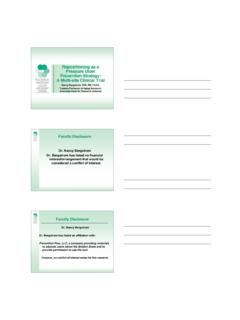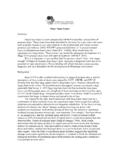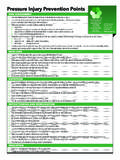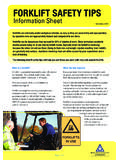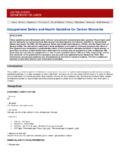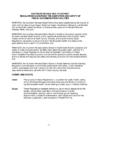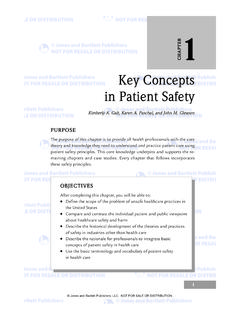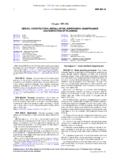Transcription of Prevention and Treatment of Pressure Ulcers: Quick ...
1 PAN PACIFICP ressure Injury AlliancePrevention and Treatment of Pressure Ulcers: Quick Reference Guide NPUAP/EPUAP/PPPIAC opyright National Pressure Ulcer Advisory Panel, European Pressure Ulcer Advisory Panel and Pan Pacific Pressure Injury AllianceISBN-10: 0-9579343-6-X ISBN-13: 978-0-9579343-6-8 First published 2009 Second edition published 2014 Published by Cambridge Media on behalf of National Pressure Ulcer Advisory Panel, European Pressure Ulcer Advisory Panel and Pan Pacific Pressure Injury AllianceAll rights reserved. Apart from any fair dealing for the purposes of private study, research or review, as permitted under the Copyright Act, no part may be reproduced or copied in any form or by any means without written permission.
2 Requests to reproduce information can be emailed to citation:National Pressure Ulcer Advisory Panel, European Pressure Ulcer Advisory Panel and Pan Pacific Pressure Injury Alliance. Prevention and Treatment of Pressure Ulcers: Quick Reference Guide. Emily Haesler (Ed.). Cambridge Media: Osborne Park, Australia; :This Quick reference guide was developed by the National Pressure Ulcer Advisory Panel, the European Pressure Ulcer Advisory Panel and the Pan Pacific Pressure Injury Alliance. It presents a comprehensive review and appraisal of the best available evidence at the time of literature search related to the assessment, diagnosis, Prevention and Treatment of Pressure ulcers.
3 The recommendations in this Quick reference guide are a general guide to appropriate clinical practice, to be implemented by qualified health professionals subject to their clinical judgment of each individual case and in consideration of the patient consumer s personal preferences and available resources. The guide should be implemented in a culturally aware and respectful manner in accordance with the principles of protection, participation and copies of the English version of this Quick reference guide can be ordered, and PDFs downloaded, from the following websites:NPUAP EPUAP Wound Management Association (AWMA) Kong Enterostomal Therapists Association Society Zealand Wound Care Society (NZWCS)
4 Wound Healing Society Singapore Pressure Ulcer Guideline PACIFICP ressure Injury Alliance NPUAP/EPUAP/PPPIA NPUAP/EPUAP/PPPIA 1 Quick REFERENCE GUIDE INTRODUCTIONINTRODUCTIONF orewordThis Quick Reference Guide presents a summary of the recommendations and excerpts of the supporting evidence for Pressure ulcer Prevention and Treatment . The more comprehensive Clinical Practice Guideline version of the guideline provides a detailed analysis and discussion of available research, critical evaluations of the assumptions and knowledge of the field, and description of the methodology used to develop guideline.
5 This Quick Reference Guide is intended for busy health professionals who require a Quick reference in caring for individuals in the clinical setting. Users should not rely on excerpts from the Quick Reference Guide alone. The first edition of the guideline was developed as a four year collaboration between the National Pressure Ulcer Advisory Panel (NPUAP) and the European Pressure Ulcer Advisory Panel (EPUAP). In this second edition of the guideline, the Pan Pacific Pressure Injury Alliance (PPPIA) has joined the NPUAP and EPUAP. The goal of this international collaboration was to develop evidence-based recommendations for the Prevention and Treatment of Pressure ulcers that could be used by health professionals throughout the world.
6 An explicit scientific methodology was used to identify and critically appraise all available research. In the absence of definitive evidence, expert opinion (often supported by indirect evidence and other guidelines) was used to make recommendations. Drafts of the recommendations and supporting evidence were made available to 986 invited stakeholders (individuals and organizations) around the world. The final guideline is based on available research and the accumulated wisdom of the NPUAP, EPUAP, PPPIA and international stakeholders. In this edition of the guideline, a consensus voting process (GRADE) was used to assign a strength to each recommendation.
7 The strength of recommendation identifies the importance of the recommendation statement based on potential to improve patient outcomes. It provides an indication to the health professional of the confidence one can have that the recommendation will do more good than harm, and can be used to assist in prioritizing Pressure ulcer related copies of the English version of the Clinical Practice Guideline are available through links provided on the following websites:NPUAP website: website: Wound Management Association (AWMA) website: Kong Enterostomal Therapist Society website: Zealand Wound Care Society (NZWCS) website: Healing Society Singapore website: Pressure Ulcer Guideline website.
8 CitationThe NPUAP, EPUAP and PPPIA welcome the use and adaptation of this guideline at an international, national and local level. We request citation as the source, using the following format:National Pressure Ulcer Advisory Panel, European Pressure Ulcer Advisory Panel and Pan Pacific Pressure Injury Alliance. Prevention and Treatment of Pressure Ulcers: Quick Reference Guide. Emily Haesler (Ed.). Cambridge Media: Osborne Park, Western Australia; 2014. NPUAP/EPUAP/PPPIA2 NPUAP/EPUAP/PPPIAQUICK REFERENCE GUIDE INTRODUCTIONL imitations and Appropriate Use of This Guideline Guidelines are systematically developed statements to assist health professional and patient consumer decisions about appropriate health care for specific clinical conditions.
9 The recommendations may not be appropriate for use in all circumstances. The decision to adopt any particular recommendation must be made by the health professional with consideration to available resources and circumstances of the individual patient. Nothing contained in this guideline is to be considered medical advice for specific cases. Because of the rigorous methodology used to develop this guideline, the Guideline Development Group members believe that the research supporting these recommendations is reliable and accurate. Every effort has been made to critically appraise the research contained within this document. However, we do not guarantee the reliability and accuracy of individual studies referenced in this document.
10 This guideline is intended for education and information purposes only. This guideline contains information that was accurate at the time of publication. Research and technology change rapidly and the recommendations contained in this guideline may be inconsistent with future advances. The health professional is responsible for maintaining a working knowledge of research and technology advances that may affect his or her clinical decision making. Generic names of products have been used. Nothing in this guideline is intended as endorsement of a specific product. Nothing in this guideline is intended as advice regarding coding standards or reimbursement regulations. The guideline does not seek to provide full safety and usage information for products and devices; however commonly available safety and usage tips have been included.




